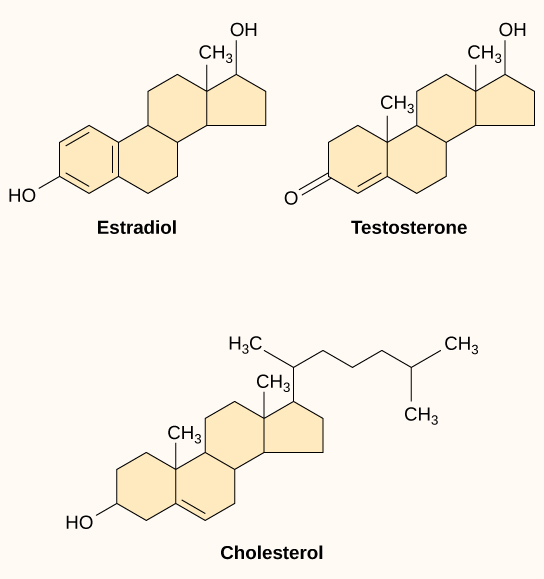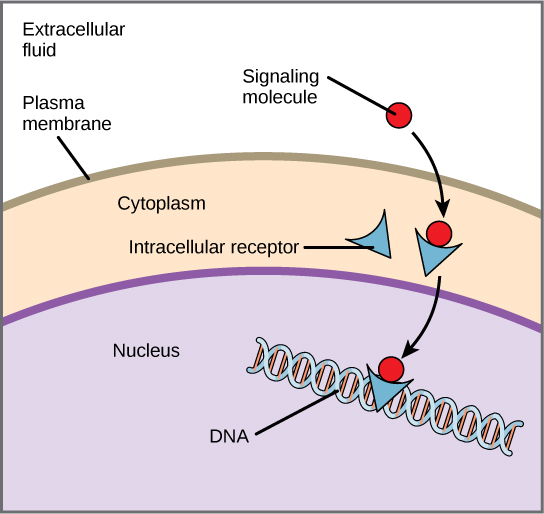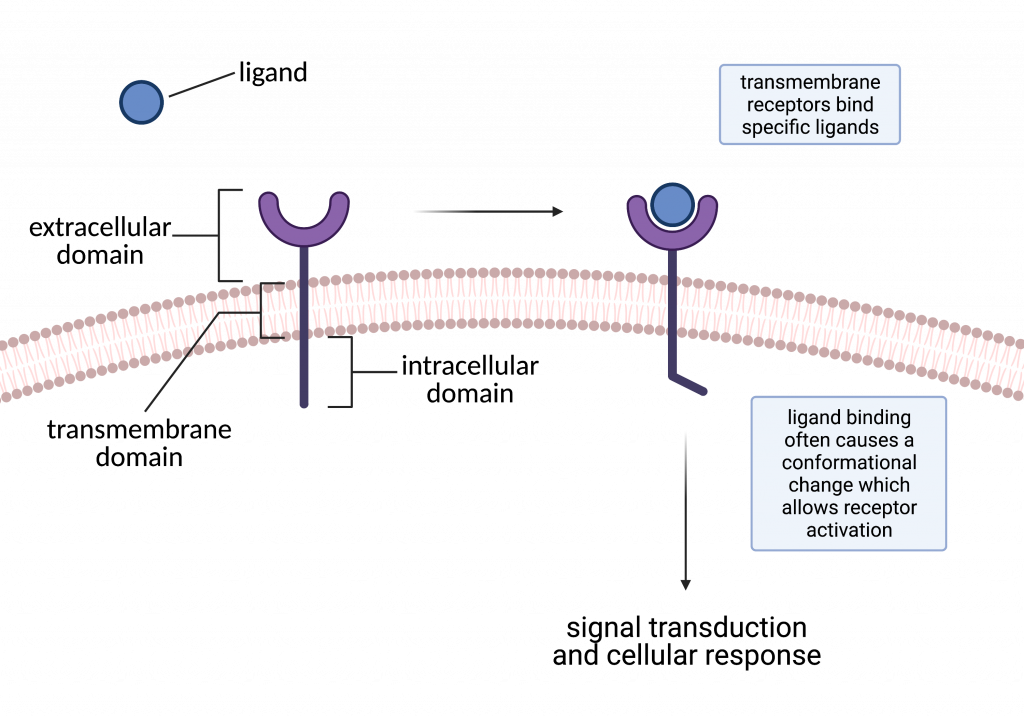11.1 Ligands and Receptors
It is vital for individual cells to be able to interact with their environment. This is true for both a one-celled organism growing in a puddle and a large animal living on a savanna. In order to properly respond to external stimuli, cells have developed complex mechanisms of communication that can receive a message, transfer the information across the plasma membrane, and then produce changes within the cell in response to the message.
In multicellular organisms, cells send and receive chemical messages constantly to coordinate the actions of distant organs, tissues, and cells. The ability to send messages quickly and efficiently enables cells to coordinate and fine-tune their functions.
Steps of Cell Signaling
Cell signaling can be divided into five steps: signal, reception, signal transduction, response, and termination.

Chemical signals are released by signaling cells in the form of small, usually volatile or soluble molecules called ligands. A ligand is a molecule that binds another specific molecule, in some cases, delivering a signal in the process. Ligands can thus be thought of as signaling molecules.
Ligands interact with proteins in target cells, which are cells that are affected by chemical signals; these proteins are called receptors. Ligands and receptors exist in several varieties; however, a specific ligand will have a specific receptor that typically binds only that ligand.
Ligands
Produced by signaling cells and the subsequent binding to receptors in target cells, ligands act as chemical signals that travel to the target cells to coordinate responses. The types of molecules that serve as ligands are incredibly varied and range from small proteins to small ions like calcium (Ca2+).
Small Hydrophobic Ligands
Small hydrophobic ligands can directly diffuse through the plasma membrane and interact with intracellular receptors. Important members of this class of ligands are the steroid hormones. Steroids are lipids that have a hydrocarbon skeleton with four fused rings; different steroids have different functional groups attached to the carbon skeleton. Steroids include the female sex hormone, estradiol, which is a type of estrogen; the male sex hormone, testosterone; and cholesterol, which is an important structural component of biological membranes and a precursor of steroid hormones. Other hydrophobic hormones include thyroid hormones and vitamin D. In order to be soluble in blood, hydrophobic ligands must bind to specific proteins while they are being transported through the bloodstream.

Water-Soluble Ligands
Hydrophilic ligands are polar and, therefore, cannot pass through the plasma membrane unaided. Sometimes they are too large to pass through the membrane at all. Instead, most water-soluble ligands bind to the extracellular domain of cell-surface receptors. This group of ligands is quite diverse and includes small molecules, peptides, and proteins.
Receptors
Receptors are protein molecules inside the target cell or on its surface that bind ligand. We can divide receptors into two main classes, intracellular receptors and cell-surface receptors.
Intracellular receptors
Intracellular (or cytoplasmic) receptors, are found in the cytoplasm of the cell and respond to hydrophobic ligand molecules that are able to travel across the plasma membrane by simple diffusion. Once inside the cell, many of these molecules bind to proteins that act as regulators of mRNA synthesis (transcription) to mediate gene expression. Gene expression is the cellular process of transforming the information in a cell’s DNA into a sequence of amino acids, which ultimately forms a protein.

When a ligand binds to an intracellular receptor, a conformational change is triggered that exposes a DNA-binding site on the protein. The ligand-receptor complex moves into the nucleus, then binds to specific regulatory regions of the chromosomal DNA and promotes the initiation of transcription. Intracellular receptors can directly influence gene expression without having to pass the signal on to other receptors or messengers.
Cell-Surface Receptors
Cell-surface receptors, also known as transmembrane receptors, are cell surface, membrane-anchored (integral) proteins that bind to external ligand molecules. This type of receptor spans the plasma membrane and performs signal transduction, through which an extracellular signal activates an intracellular signal. Ligands that interact with cell-surface receptors do not have to enter the cell that they affect. Some cell-surface receptors are also called cell-specific proteins or markers because they are specific to individual cell types.
Because cell-surface receptor proteins are fundamental to normal cell functioning, it should come as no surprise that a malfunction in any one of these proteins could have severe consequences. Errors in the protein structures of certain receptor molecules have been shown to play a role in hypertension (high blood pressure), asthma, heart disease, and cancer.
Each cell-surface receptor has three main components: an external ligand-binding domain called the extracellular domain, a hydrophobic membrane-spanning region called a transmembrane domain, and an intracellular domain inside the cell that can connect to a specific signal transduction pathway. The size and extent of each of these domains vary widely, depending on the type of receptor.

cell that releases signal molecules that allow communication with another cell
a molecule that binds to a protein
protein in or on a target cell that binds to ligands, resulting in a response
molecules that do not interact well with water; nonpolar molecules
molecules that interact well with water, such as ions and polar molecules
cell that has a receptor for a signal or ligand from a signaling cell
receptor protein that is located in the cytosol of a cell and binds to ligands that pass through the plasma membrane
cell-surface protein that transmits a signal from the exterior of the cell to the interior, even though the ligand does not enter the cell

